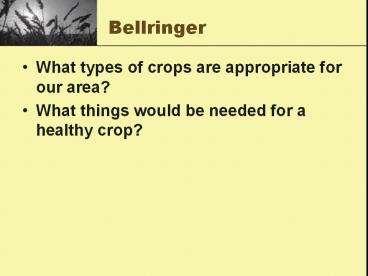Bellringer - PowerPoint PPT Presentation
Title:
Bellringer
Description:
What types of crops are appropriate for our area? What things would be needed for a healthy crop? Crops and Soil Section 15.2 Objectives: Describe land-use practices ... – PowerPoint PPT presentation
Number of Views:62
Avg rating:3.0/5.0
Title: Bellringer
1
Bellringer
- What types of crops are appropriate for our area?
- What things would be needed for a healthy crop?
2
Crops and SoilSection 15.2
- Objectives
- Describe land-use practices that promote
sustainability and economic growth. - Identifying ways to manage waste.
- Describe the composition of soil profiles.
- Identifying various processes and activities that
promote soil formation. - Describe agents of erosion and methods for
preventing soil erosion.
3
Agriculture
- Arable land see your vocabulary for def.
Basic farming process Traditional methods Modern methods
Plowing Read p.384 to fill in this chart
Fertilization
Irrigation
Pest control
4
Fertile Soil
- Can support healthy plant growth
- Topsoil
- surface layer of soil
- usually richer in organic matter than the
subsoil - where plant roots grow
- Formation of fertile soil
- Weathered rock particles supply mineral
nutrients. - Fungi and bacteria for decomposition
- Earthworms, insects, and small animals break up
the soil, allowing air and water into it.
5
Soil Profile (Fig. 8, p.385)
6
Assignment
- Fold your paper in half hotdog style.
- Draw and color a soil profile showing details of
all 6 layers. (Your drawing should take up the
whole front of your folded paper.) - Cut the layers apart, creating 6 flaps.
- On the inside, label and describe each layer.
(Example O Horizon/Surface litter fallen
leaves and dead animals)
7
Soil Erosion and Land Degradation
- Erosion the wearing away of rock or soil by wind
or water - In the U.S., ½ the topsoil has been lost to
erosion in the past 200 years. Why is this a
problem? - It takes a long time to form soil.
- Without fertile topsoil, crops cannot be
supported. Most farming methods make erosion
worse!!! - Land degradation damaging land so that it can
no longer support the local ecosystem.
8
Soil Erosion and Land Degradation (cont.)
- Desertification the process by which land in
arid or semiarid areas becomes more desertlike - Human causes of desertification
- Overplanting planting too many crops too
frequently - Not enough fallow time (when land is left
unplanted to allow it to recover) - Overgrazing , which eliminates plants that hold
topsoil in place
9
Real-Life Examples
- Northern Africa
- Dust Bowl, 1930s
10
Soil Conservation Methods
- In which direction would soil erode on any degree
of slope? - Ways to reduce erosion on sloped land
- Terracing stairsteps of level field areas going
up a hill - Contour plowing plowing along the natural
contour of the land
11
Soil Conservation Methods (cont.)
- No-till farming
- Leave crop remains to hold soil in place.
- Also saves time
- Soil may become too densely packed and lower crop
yields.
12
Enriching the Soil
- Traditionally vs. Chemically
- Advantages of each
- Disadvantages of each
- Compost partially decomposed organic material
(both plant and animal!)
13
Salinization
- Def. the accumulation of salts in soil
- A problem in areas of low rainfall
- Irrigation water comes from rivers or groundwater
(saltier than rainwater) - When water evaporates, the salts remain behind,
accumulating in the soil. - Too much salt plants cannot grow
14
Assignment
- Both wars and drought can lead to famine. In what
ways do they have similar effects, and in what
ways are their effects different? - Write a paragraph to explain your answers.
15
Pest Control
- In North America, pests destroy about 13 of all
crops in Kenya, more than 25 more than 33
worldwide. - Why the differences?
- Pest any organism that occurs where it is not
wanted or that occurs in large enough numbers to
cause economic damage NOT limited to insects! - Pest control is one benefit of crop rotation.
(Know why! p.389)
16
Pesticides
- Def. ???
- Can also harm beneficial plants and insects,
wildlife, and people - Disadvantages of pesticide use
- Pests may develop resistance to chemicals.
- Human health concerns (cancer, nervous system
disorders, etc.) - Persistent pesticides (pesticides that do not
break down rapidly) accumulate in the water and
soil. (EX DDT, banned in the 70s, still
detected in environment and breast milk)
17
Biological Pest Control
- Def. Using living organism to control pests.
- All organisms have natural enemies!
- Types of biological pest control
- Pathogens organisms that cause disease (EX Bt,
a bactrium, kills caterpillars of moths and
butterflies) - Plant defenses chemical compounds that repel
insects, plants barriers such as tougher skin - Disrupting insect breeding
- Growth regulators interfere with some stage of
an insects life cycle - Pheromones can be used to confuse mating habits
- Expose males to x-rays to sterilize them
18
Genetic Engineering
- Def. genetic material in a living cell is
modified for medical or industrial use - Plants created by genetic engineering are called
genetically modified (GM) plants. - These plants are usually bred for their
resistance.
19
Sustainable Agriculture
- What do you think the phrase sustainable
agriculture means? - What techniques/products/resources do you think
would be limited (used in limited amounts or not
at all) in this type of farming? - What techniques would be used more?
20
GM Foods Project Assignment ?































